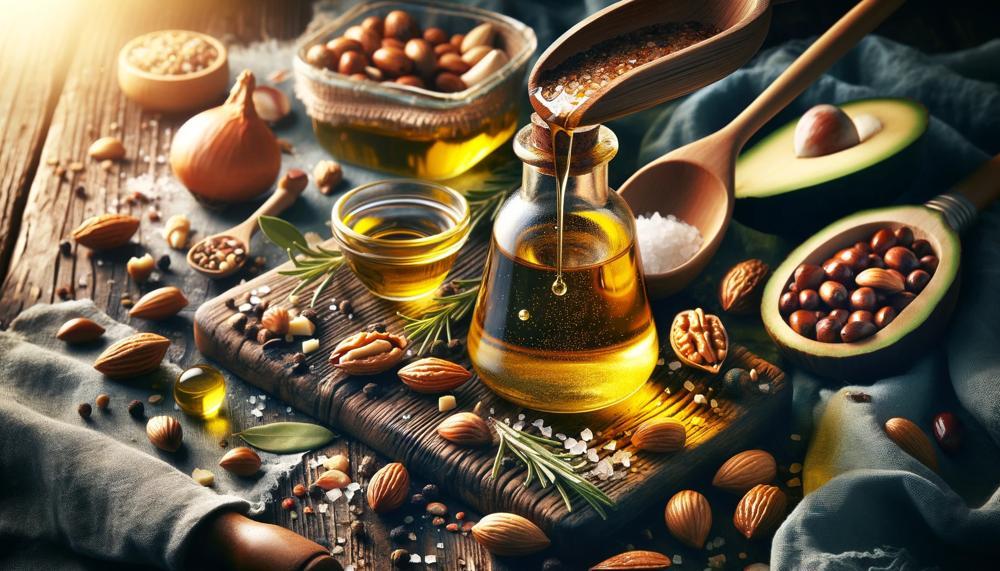As a professional cook, I understand the importance of using fresh and safe ingredients in the kitchen. Cooking oil is a staple in every chef’s pantry, but did you know that it can go bad over time? It’s crucial to know the signs of bad oil to ensure the quality and safety of your culinary creations.
In this article, I will provide you with valuable information on determining if your cooking oil has gone bad, how to choose the right oil, and tips for using it efficiently. Let’s dive in.
Contents
Key Takeaways:
- Bad cooking oil can affect the taste and quality of your food.
- Using your senses, like taste, smell, and appearance, you can determine if the oil is rancid.
- Proper storage, choosing the right oil, and using it efficiently can help prolong its freshness.
- Recycling used cooking oil is an eco-friendly option.
- Regularly monitoring the freshness of your cooking oil is essential for maintaining the quality and safety of your dishes.
How to Know If Cooking Oil Is Bad?
Here are some ways to tell if cooking oil has gone bad:
- Smell: Fresh oil has a neutral smell. Rancid oil smells slightly sweet, like adhesive paste, or has a fermented odor.
- Taste: Taste the fried foods.
- Appearance: Bad oil can be:
- Discolored
- Cloudy
- Thicker
- Sticky
- Foamy
- Darker
- Gummy
- Sedimentous
- Smoke point: Bad oil will burn before its original smoke point.
- Other signs: Bad oil may have a musty, fishy smell.
- Cooking oil can degrade over time due to oxidation and light exposure. The US Department of Health and Human Services recommends keeping unopened olive and vegetable oils in a dark, dry place for 6 to 12 months after the purchase date.
Does Vegetable Oil Go Bad?
Vegetable oil, like any other cooking oil, has a shelf life and can go bad over time. Various factors, such as the type of oil, its use, and storage conditions, can contribute to its spoilage and breakdown. Heat, air, moisture, and light can accelerate the degradation of vegetable oil, causing it to become rancid.
Proper storage is key to prolonging the shelf life of vegetable oil. Storing it in dry, airtight containers away from light and heat can help preserve its freshness. By following these storage guidelines, vegetable oil can maintain its quality and usability for an extended period.
It is important to note that different oils have different shelf lives. While some vegetable oils can last up to two years when stored properly, others may have a shorter shelf life. Understanding the specific shelf life of the vegetable oil you are using will help ensure its freshness.
| Factors Affecting Shelf Life of Vegetable Oil | Shelf Life (When Stored Properly) |
|---|---|
| Type of Vegetable Oil | Variable – Consult product packaging or manufacturer guidelines |
| Use | Dependent on personal consumption rate |
| Storage Conditions | Up to two years |
By understanding the factors that contribute to the spoilage of vegetable oil and implementing proper storage practices, you can maximize its shelf life and minimize the likelihood of experiencing rancid or degraded oil in your kitchen.
Choosing and Using Cooking Oil
When it comes to cooking oil, there are several factors to consider in order to make the right choice for your culinary needs. Factors such as flavor, smoke point, quality, and affordability play a crucial role in determining which oil is best suited for your dishes. Here’s a closer look at each of these considerations:
Flavor
The flavor of the oil can significantly impact the taste of your food. Some oils, like olive oil, have a distinct flavor that can enhance certain dishes, while others, like canola oil, have a more neutral taste that won’t overpower the flavors of your ingredients. Consider the flavor profile of your dish and choose an oil that complements it.
Smoke Point
The smoke point of an oil is the temperature at which it starts to break down and produce smoke. Cooking oils with higher smoke points are ideal for high-heat cooking methods like frying and sautéing, as they can withstand the heat without burning and imparting an unpleasant flavor to the food. Aim for an oil with a smoke point of at least 350 degrees Fahrenheit to ensure optimal cooking results.
Quality
Higher-quality oils tend to have better flavor profiles, undergo stricter quality control measures, and offer enhanced health benefits. While these oils may be more expensive, their superior quality can make a noticeable difference in the taste and overall quality of your dishes. Consider investing in higher-quality oils for special occasions or dishes that require an extra level of finesse.
Affordability
Affordability is another important consideration, especially for commercial kitchens or budget-conscious home cooks. While high-quality oils may come at a higher price, there are also affordable options available that offer decent flavor and performance. Consider your budget and the frequency of oil usage to strike the right balance between quality and affordability.
Using Oil Efficiently
Using oil efficiently not only helps stretch your budget but also ensures that your oil lasts longer. Here are some tips for using oil efficiently:
- Fill fryers to the indicated level to avoid using excess oil.
- Turn off and cover the fryer when not in use to prevent oil oxidation.
- Regularly filter the oil to remove impurities and extend its usability.
By following these tips and considering the factors mentioned above, you can choose the right cooking oil for your unique needs and use it efficiently to create delicious, flavorful dishes.
Signs of Rancid Oil
Rancid oil can negatively impact the taste and quality of your food. When determining if oil is rancid, it’s important to rely on your senses. There are several key signs that can indicate the presence of rancidity.
- Taste: Rancid oil often has a sharp or unpleasant taste that can significantly alter the flavor of your dishes.
- Smell: A distinct odor is another telltale sign of rancid oil. It may have an off-putting scent that is different from the fresh smell of good oil.
- Appearance: Rancid oil can undergo noticeable changes in appearance. It might become discolored, appearing darker or have a cloudy and murky appearance. The texture may become thicker and more viscous, and the oil can develop a sticky feel. Some rancid oils may even form a foamy film on the surface.
If you notice any of these signs, it’s crucial to discard the rancid oil and replace it with fresh oil to maintain the quality and taste of your culinary creations.
Reusing and Recycling Cooking Oil
When it comes to cooking oil, reusing it to a certain extent is possible, but once it reaches its limit, recycling is the best option. Recycling used cooking oil not only helps with waste management but also contributes to the production of biofuel, an eco-friendly alternative. Many professional services specialize in the collection and recycling of used cooking oil, simplifying the process for restaurants.
By partnering with a reputable recycling service, you can ensure that your used cooking oil is disposed of responsibly and put to good use in the production of biofuel. This helps minimize environmental impact and promotes sustainability in the restaurant industry.
Benefits of Reusing and Recycling Cooking Oil
- Environmental impact: Recycling used cooking oil reduces the amount of waste that would otherwise end up in landfills or be improperly disposed of.
- Biofuel production: The recycling process converts used cooking oil into biofuel, an alternative energy source that can help reduce greenhouse gas emissions.
- Cost savings: Reusing oil to a certain extent can help save on expenses, while recycling eliminates the need for costly disposal methods.
- Sustainable practices: By reusing and recycling cooking oil, restaurants can demonstrate their commitment to sustainable practices, attracting environmentally conscious customers.
Comparing Reusing and Recycling Cooking Oil
| Reusing Oil | Recycling Oil |
|---|---|
| Extended use of oil | Eco-friendly disposal |
| Potential cost savings | Biofuel production |
| Requires proper storage and monitoring | Partnering with a professional recycling service |
In conclusion, reusing cooking oil to a certain extent can help save costs, but recycling it is the ideal solution for long-term sustainability. By partnering with a professional service, you can ensure that your used cooking oil is disposed of responsibly and contributes to the production of biofuel. Making the switch to recycling not only benefits your restaurant but also the environment and the community at large.
Determining Freshness of Cooking Oil

When it comes to cooking oil, freshness is key to achieving the best results in your dishes. Over time, oil can break down and lose its quality, resulting in undesirable flavors and potentially compromising the taste of your food. To ensure that your cooking oil is fresh and in its optimal condition, there are several indicators you can look for:
- Appearance: Pay attention to the color and consistency of the oil. Fresh oil typically has a clear, golden hue. If the oil starts to darken and becomes thicker or gummy in texture, it may have gone bad.
- Smell: Give the oil a whiff and take note of any peculiar or unpleasant odors. Fresh oil should have a neutral or mild aroma. If you detect any acrid or bitter smells, it could be a sign of rancidity.
- Taste: The final test for determining the freshness of cooking oil is through taste. Prepare a small sample of food using the oil and pay close attention to the flavor. If the oil has gone bad, it may impart off-flavors to your dish, affecting the overall taste.
By meticulously assessing the appearance, smell, and taste of your cooking oil, you can ensure that it is fresh and suitable for use. Regularly inspecting your oil is particularly crucial for restaurants and food establishments that heavily rely on deep fryers, as prolonged use can expedite the breakdown process. Remember, using fresh oil not only enhances the taste of your dishes but also promotes food safety.
Understanding Rancidity in Different Oils
Culinary oils, composed mostly of triglycerides, can undergo a process of oxidation and decomposition over time, leading to the development of rancidity. While refined oils such as vegetable or canola oil can be easily detected for rancidity by their distinctive odor, identifying rancidity in unrefined oils can be more challenging.
Extra-virgin olive oil, for example, may not exhibit evident signs of rancidity through smell alone. To determine if unrefined oil has gone rancid, it is recommended to taste the oil and observe any off-flavors resulting from the combination of its natural flavor and rancidity aromas.
Apart from changes in taste and smell, rancid oils may also undergo alterations in texture. They can become sticky, further indicating their degradation.
Conclusion
Knowing the signs of bad cooking oil is crucial for maintaining the quality and safety of your food. By paying attention to changes in taste, smell, and appearance, you can easily determine if your cooking oil has gone bad. Proper storage, such as keeping it in a cool, dry place away from heat and light, can help prolong its freshness and prevent rancidity.
Choosing the right cooking oil for your needs is equally important. Consider factors like smoke point, flavor, and quality to ensure optimal cooking results. Using the oil efficiently, such as filtering it regularly and following recommended usage guidelines, can also extend its lifespan.
When it’s time to replace your cooking oil, don’t forget about eco-friendly disposal options. Recycling used cooking oil is a responsible choice that helps reduce waste and promote sustainability. Consider partnering with a professional service to ensure proper recycling and repurposing of your used oil.
By following these guidelines, you can ensure that your cooking oil remains fresh, safe, and enjoyable to use. Keeping a keen eye on signs of freshness and practicing responsible recycling not only benefits your kitchen but also the environment.
Source Links
- https://www.darpro-solutions.com/media/blog/does-vegetable-oil-go-bad
- https://www.americastestkitchen.com/cooksillustrated/articles/2978-how-to-tell-if-an-oil-is-rancid




